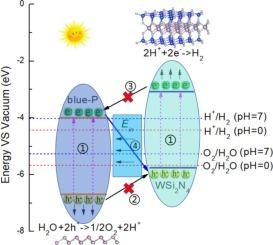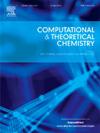Study on electronic and optical properties of novel potential photocatalytic water splitting material: Z-scheme blue-P/WSi2N4 vdW heterostructure
IF 3
3区 化学
Q3 CHEMISTRY, PHYSICAL
引用次数: 0
Abstract
In this study, four blue-P/WSi₂N₄ van der Waals (vdW) heterostructures were designed based on the blue-P and WSi₂N₄ monolayers, with the AA-stacking configuration (AA-HS) identified as the most stable. Then we investigated the structural, electronic, and photocatalytic properties of AA-HS via first-principles calculations. Electronic structure analysis reveals it has an indirect bandgap of 1.75 eV (HSE method) and a type-II band alignment, where the valence band maximum (VBM) and conduction band minimum are localized on the blue-P and WSi₂N₄ layers, respectively. A built-in electric field drives Z-scheme charge transfer, suppressing interfacial recombination while preserving redox-active sites. The AA-HS demonstrates strong redox capability, with the VBM of blue-P layer much lower than the O₂/H₂O potentials and the CBM of WSi₂N₄ layer much higher than the H+/H₂ potentials, enabling efficient water splitting. The good light absorption ability further confirms its potential as a high-performance Z-scheme photocatalyst

新型潜在光催化水分解材料:Z-scheme blue-P/WSi2N4 vdW异质结构的电子和光学性质研究
在本研究中,基于蓝- p和WSi₂N₄单层设计了四种蓝- p /WSi₂N₄van der Waals (vdW)异质结构,并确定了aa -堆叠构型(AA-HS)最稳定。然后通过第一性原理计算研究了AA-HS的结构、电子和光催化性质。电子结构分析表明,该材料具有1.75 eV的间接带隙(HSE法)和ii型带取向,其中价带最大值(VBM)和导带最小值分别位于blue-P层和WSi₂N₄层。内置电场驱动Z-scheme电荷转移,抑制界面重组,同时保留氧化还原活性位点。AA-HS具有较强的氧化还原能力,blue-P层的VBM远低于O₂/H₂O电位,WSi₂N₄层的CBM远高于H+/H₂电位,实现了高效的水分解。良好的光吸收能力进一步证实了其作为高性能z型光催化剂的潜力
本文章由计算机程序翻译,如有差异,请以英文原文为准。
求助全文
约1分钟内获得全文
求助全文
来源期刊

Computational and Theoretical Chemistry
CHEMISTRY, PHYSICAL-
CiteScore
4.20
自引率
10.70%
发文量
331
审稿时长
31 days
期刊介绍:
Computational and Theoretical Chemistry publishes high quality, original reports of significance in computational and theoretical chemistry including those that deal with problems of structure, properties, energetics, weak interactions, reaction mechanisms, catalysis, and reaction rates involving atoms, molecules, clusters, surfaces, and bulk matter.
 求助内容:
求助内容: 应助结果提醒方式:
应助结果提醒方式:


